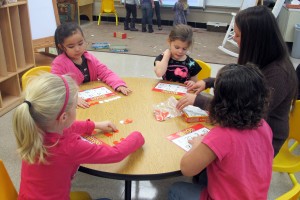How Indiana Education Officials Want To Improve Pre-K, Even If Lawmakers’ Plan Doesn’t Pass

Elle Moxley / StateImpact Indiana
Students play a bingo game to help improve their counting skills at Busy Bees Academy, a public preschool in Columbus.
The pre-K pilot proposal that passed easily in the House last week will face an uphill battle when it reaches the Senate Education Committee later this month.
Similar legislation fizzled last year when it reached the upper chamber, where Senators cited cost concerns and scaled back the proposal.
“Obviously this is a short session, not a budget session,” says Indiana Department of Education spokesman Daniel Altman. “As far as what’s going to happen with this legislation, I think it’s up in the air.”
But Altman says the department, which supports lawmakers’ pre-K proposal, has a plan for developing the administrative and data systems necessary to support Indiana’s early learning programs, even if funding for a voucher program doesn’t materialize this year.
“We’re definitely talking about things that can be accomplished with little to no additional funding so we can make sure when the funding does come, we’re laying the groundwork right now,” he says.
Indiana is one of 10 states that doesn’t provide any public money for preschool. As a result, the state relies on a disparate network of public and private childcare providers to provide services to children ages 0 to 5.
As we’ve written before, that leaves state education officials without much to go on when kids get to kindergarten. According to IDOE Early Learning Director Charlie Geier, there’s no official count of how many kids attend preschool in Indiana — let alone how many are enrolled in a high quality option.
“That’s a challenge,” says Geier. “There’s no doubt about it, especially when you think about the early learning community — it’s 5,000 private providers.”
And only about half of them are participating in the state’s Paths to Quality rating system, which is administered by the Family and Social Services Administration. It’s the only real indicator Indiana has on the state of pre-K.That lack of infrastructure hurt the state in a competition for the latest round of federal Race to the Top Early Learning Challenge grant dollars. Indiana’s neighbors — Illinois, Kentucky, Michigan, Ohio and Wisconsin — have all received grants to bolster their pre-K initiatives. Geier says Indiana needs to make changes now to make sure it doesn’t fall further behind.
The good news, he says, is most of the changes can be made without much additional funding. Here’s what’s on the department’s pre-K wish list:
5 Things Education Officials Say Will Improve Pre-K’s Chances
- Third grade. Most research suggests the early learning years continue until age 8, but pre-K cuts off at age 5 when kids enter the school system. That means making sure schools treat grades K-3 as part of a continuum that includes preschool.
- Accountability. Geier says Indiana already has a strong accountability system through the state’s FSSA Paths to Quality ratings. But not all childcare providers participate, and officials have no way to keep track of the ones that don’t. Getting more providers rated would give the department a better idea of who’s offering quality programs. (Incidentally, Sen. Luke Kenley, R-Noblesville, filed legislation that would offer a property tax exemption to early learning providers who sign up for the rating system and earn high marks. The bill has yet to get a hearing in committee.)
- Standards. With the ongoing review of the state’s Common Core academic standards, Geier says Indiana has an opportunity to make sure best practices for early learning are addressed in the early grades. He says independent Indiana expectations will also give educators a chance to address concerns the nationally-crafted standards aren’t developmentally appropriate for very young children.
- Transition. Only about 2 percent of kindergarteners get to school with any kind of documentation of what they learned in preschool. That means kindergarten teachers spend a lot of time just figuring out which students need what, not necessarily teaching.
- Assessment. Indiana has a free tool pre-K teachers can use to make observations about students’ developmental progress. But the ISTAR-KR isn’t mandatory or widely used. At the very least, Geier says making sure all students are screened once they get to kindergarten would help measure how ready they are to start school. And that could help cut down on the $17 million the state spent last year to retain kindergarteners who weren’t ready to start school.


